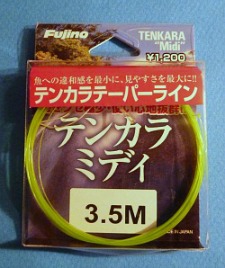Trip Report 8-17-13
Unusual for a Saturday, I headed up to one of the streams that run between the NYC water supply reservoirs just north of the city. I went fishing on a Saturday instead of staying home filling orders because I had recently acquired a used Oni rod and I was anxious to give it a shake on some moving water. I had taken it to Central Park last Saturday after picking it up at the post office, but "Tenkara in the Park" leaves quite a lot to be desired. (At least it does if it's Central Park. Rocky Mountain National Park, Yellowstone, Yosemite, etc. are a completely different story.)
I've been curious about the Oni rod for some time. I'd had a chance to cast one on my first trip to Japan in 2010, but Masami Sakakibara (Tenkara no Oni) continuously improves his rods and the current rod is not the same as his 2010 model. Also, that was in a parking lot, and parking lot casting is even less satisfying than lawn casting.
Tenkara no Oni is known for his casting skill, particularly with very long lines and with very light lines. No one should think they can buy an Oni rod and be transformed into a long line or light line casting demon. Tenkara no Oni's ability comes from years of practice, not a magic wand. It's not the sword, it's the swordsman.
That said, the rod is unique. When I brought it home from the post office, I quickly laid out a couple rods I wanted to compare it to: my trusty Daiwa LL41SF and a Nissin Zerosum 400. Once I got the rod out of the case and wiggled it, I just put the other rods away. There was no point comparing them because they were so obviously apples and oranges. The Oni rod is not at all like them. It is not at all like any other rod.
With the first wiggle, I thought "My word, this is a seiryu rod. No wonder it casts a light line." After putting away the tenkara rods and pulling out some seiryu rods, I had to conclude that it doesn't quite feel like my seiryu rods either (although it does feel a lot more like a seiryu rod than a tenkara rod). And to those anglers who still believe that a rod isn't a tenkara rod unless it has a cork or foam or wooden grip, all I can say is they can believe what they want. I am now more convinced than ever before that what is important is the blank, not the grip.
As soon as I got to the stream, I tied
on a size 2 line a couple feet longer than the rod. I was curious to see if the Oni rod really was a star at casting light lines. I was not disappointed, but
then I had expected it to cast a size 2 line pretty well.
Although the
Oni rod has been reviewed by
Jason Klass and Tom Davis, my expectation was not based on their
reviews.
Neither of them are light line aficionados. Jason wrote his review after
fishing with a size 3 line (down from his usual size 4). Tom didn't
mention
what size line he used, but I have searched through all his blog posts
this year and have found no mention of him using a line lighter than a
3. Size 3 is not a heavy line, but I would not say it is especially light, and you don't have to buy a special rod to be able to cast it.
Tenkara no Oni's reputation for fishing light lines certainly suggests that a rod bearing his name would handle them well. Again, not wanting to confuse the sword with the swordsman, just because he can cast a light line with it doesn't mean I would be able to. No, my expectation was based mostly on the fact that the rod's flex is similar to the seiryu rods with which I already often do fish size 2 lines.
My pass through the section of the stream which is usually the most productive for me turned out to be little more than casting practice - or rather, casting evaluation. Zilch, zip, nada - not so much as a tap (nice casts, though). I moved to my second spot, which is quite a bit tighter. No line longer than the rod here. I replaced the size 2 level line with a 3.5m Tenkara MIDI tapered line. I learned of these lines from YoshidaKebari, and the more I fish with them the better I like them. They're nylon, so they're not "wind lines," but on a quiet day and with a softer rod they do cast well. In a tighter spot, the 3.5m MIDI line on a 4m rod is really very nice. Pinpoint accuracy and fly-first presentations.
I also replaced the fly, taking off the size 12 unweighted sakasa kebari I usually use when initially test casting a new rod and putting on a size 6 Keeper Kebari, which has proven itself with smallmouth bass, bluegills and small wild trout. Actually, it is a direct descendant of the Sakakibara Kebari I tied on the Tying Tenkara Flies DVD, which was tied on a size 6 hook because I couldn't bring myself to buy the size 2 hooks Sakakibara occasionally uses. I have since tried size 2 kebari and have gone back to the size 6. The Daiichi 1560 is a 1XL nymph hook, so the fly is about the same size as it would be tied on a size 4 wet fly hook.
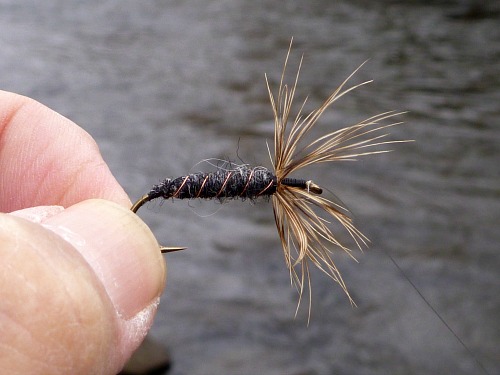
Keeper Kebari
Hook: Daiichi 1560 size 6
Thread: 6/0 UNI-Thread, black
Hackle: Hen Pheasant breast feather
Body: Little Dark Kebari yarn
I dutifully probed all the spots in this second section where I have caught fish before, and it was starting to look like more casting practice when I got a tap. I missed it, but at least I knew there were still fish in the stream. And then, fishing from the inside of a bend, casting to the deeper water along the far bank, fish on! It was a modest fish (photo upper right), certainly no more than 10", but it meant I wasn't skunked and the day was officially a success.
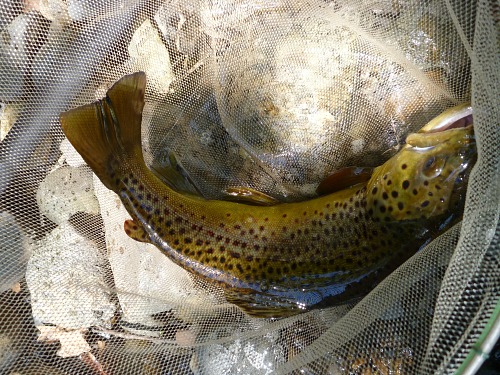 For scale, the Oni rod grip in the background has a diameter of about 1.125"
For scale, the Oni rod grip in the background has a diameter of about 1.125"A couple casts later and a bit tighter towards the bank and Hello! This was no modest fish (at least, not around these parts). I would guess it was about 16-17" and with the current, the fish did not willingly come to hand. He did what fish always do in this stream when I hook them on a seiryu rod. After a bit of a fight, they come to a point maybe 10 or 12 feet away and just hug the bottom. The fish is too close for a soft rod like a seiryu rod or the Oni rod to put any pressure on it. The last few sections of the rod just bend.
The stream
bank is lined with trees and I cannot tip the rod back over my shoulder without
getting the rod tip caught in overhead branches. In this particular spot, there
is no "soft water" and there are no bank eddies into which I could guide the fish. Hand
lining a 16" fish that is not ready to come in, while fishing with a 6X tippet and standing in current is a game of give and take and is hard enough with a short line (even a line shorter than the rod if the rod is soft and the fish is large).
I wouldn't want to even try it with a long line.
I don't have a good photo of the fish. It was much too large to hold with one hand and I didn't want to lay it on the rocks where it would surely flop around as I was trying to get a picture. To get a sense of scale, the grip of the Oni rod, seen in the upper left and looking through the net, is a bit over an inch in diameter.
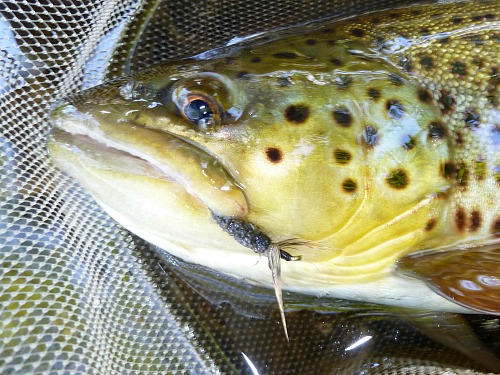 Keeper Kebari found its mark
Keeper Kebari found its markNo more than a couple casts later, and only a few feet further upstream, I hooked another! Same size, same fight, same sulking on the bottom. While it was sulking on the bottom, I had plenty of time to get out my camera and take several photos trying to show the nearly vertical, completely motionless line.
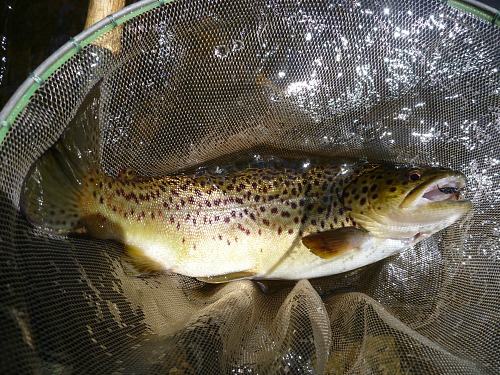 For scale, the yarn body of the fly is about 1/2" long. I don't always catch minnows.
For scale, the yarn body of the fly is about 1/2" long. I don't always catch minnows.In the end, I chose not to include any of
the photos for three reasons: 1) as
visible as the line is to the eye, it really doesn't show up all that
well in photos, 2)
it turned out there was a recognizable feature in the background, and
although the stream is very well known and thus no secret, in several
years of fishing it I have only once seen another angler in this
particular spot, and 3) truth be
told, the photos looked exactly like I was just snagged on the bottom.
Actually, it felt about like that, too. The fish didn't want to move and I couldn't put enough pressure on it to move it. Eventually it made a break downstream, which allowed me to swing the rod upstream and reach the line. The hand lining give and take was a bit different this time. He took, I gave, over and over and over. Good thing the stream is a tailwater and thus always cold.
Fishing the rest of that run was
uneventful, and with the Oni rod having gotten a good workout, I moved to my next
spot and switched to a Shimotsuke Mai. The Mai is not as soft as the Oni rod,
but it is more full flex. It cast the same size 2 line as the Oni rod, although
not quite as well. It is much happier with a size 3 line.
This third spot
on the stream yielded more frustrations than fish. I did get a quick bump, but
it was at the extreme end of the drift on an upstream cast. The rod was in a
position where there was no leverage left for a strike. Put that down as a
reason why upstream tenkara is a game of
frequent casts and short drifts, so you can still strike if you get a hit at the end of a drift.
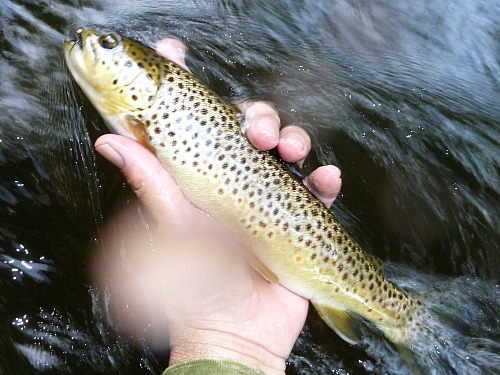
My most consistent spot on this stretch of stream had a
couple picnickers right at my spot. They were on shore, of course, but they were
RIGHT THERE. I reluctantly passed it by. I fished a bit further upstream and
managed to pick up just one more fish. By then the shadows were getting long and I
was getting ready to call it a day.
Thinking back over the day, I decided not to do a formal review of the Oni rod. I also decided not to keep it. I must be the only person in the country that wasn't wowed by it. I've already sold it and I hope its new owner is as taken by it as Jason Klass and Tom Davis clearly are with theirs.
Please note this report was written before the Oni Type II and Type III rods were released. Echoing the comment that Oni continuously improves his rods, I do not think the rod I had was identical to the current Oni Type I, which I got a chance to cast at the first Oni School in Utah. Granted, almost two years had passed, but it struck me as very different from the rod I remembered.
TenkaraBum Home > Seiryu Trip Reports > Trip Report 8-17-13
“The bitterness of poor quality remains long after the sweetness of low price is forgotten” - Benjamin Franklin
"Be sure in casting, that your fly fall first into the water, for if the line fall first, it scares or frightens the fish..." -
Col. Robert Venables 1662
As age slows my pace, I will become more like the heron.
We've all had situations where seriously chewed up flies kept catching fish after fish after fish. It is no sin to tie flies that come off the vise looking seriously chewed up.
Warning:
The hooks are sharp.
The coffee's hot.
The fish are slippery when wet.
Beware of the Dogma
Seriously, all the hooks sold on TenkaraBum.com, whether packaged as loose hooks or incorporated into flies, are sharp - or as Daiichi says on their hook packages, Dangerously Sharp. Some have barbs, which make removal from skin, eyes or clothing difficult. Wear eye protection. Wear a broad-brimmed hat. If you fish with or around children, bend down all hook barbs and make sure the children wear eye protection and broad-brimmed hats. Be aware of your back cast so no one gets hooked.
Also, all the rods sold on TenkaraBum.com will conduct electricity. Do not, under any circumstances, fish during a thunder storm. Consider any fishing rod to be a lightning rod! Fishing rods can and do get hit by lightning!
What's in stock?
Kurenai II AR 30F
Kurenai II AR 33F
Kurenai II AR 39F
TenkaraBum 33
TenkaraBum 36
Furaibo TF39
Furaibo TF39TA
Nissin Oni Tenkara Line
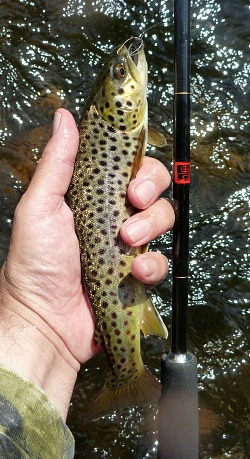 Oni Rod with the smallest trout of the day
Oni Rod with the smallest trout of the day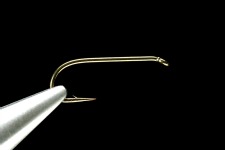 Daiichi 1560
Daiichi 1560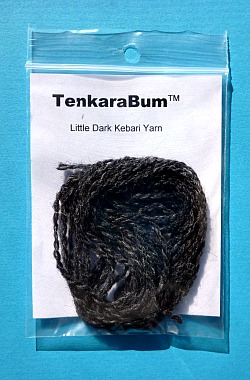
If you enjoy spin fishing or baitcasting please visit my sister site Finesse-Fishing.com.



